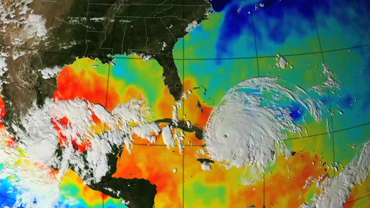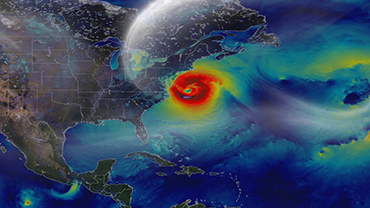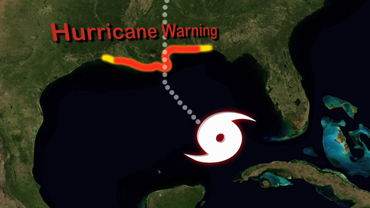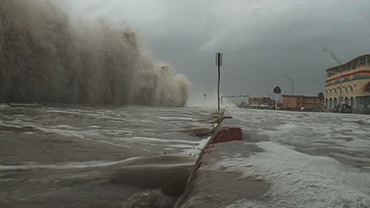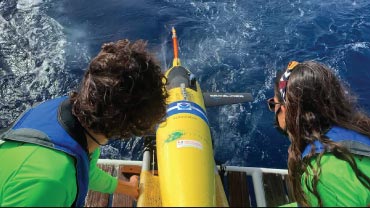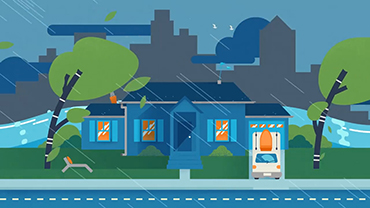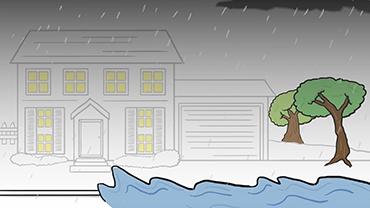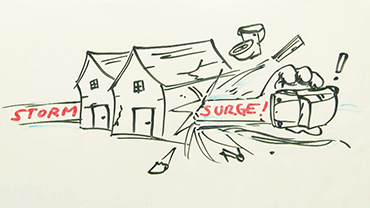Transcript
NARRATOR:
We’ve all heard that hurricanes are one of the most powerful and destructive forces on Earth. But did you ever wonder where they get their strength?
The formation of a hurricane is complicated, but basically, it depends on 3 factors:
First, you need warm water, at least 80 degrees.
The second ingredient is moist air.
And finally, there needs to be converging winds for a hurricane to form.
The actual process begins with a cluster of thunderstorms moving across the surface of the ocean. When the surface water is warm, the storm sucks up heat energy from the water, just like a straw sucks up a liquid. This creates moisture in the air. If wind conditions are right, the storm becomes a hurricane.
This heat energy is the fuel for the storm. And the warmer the water, the more moisture is in the air. And that could mean bigger and stronger hurricanes. Satellite data shows the heat and energy transfer in action. Notice how this hurricane leaves a trail of cooler water behind.
Scientists use sea surface temperature data from satellites to help forecast the intensity of storms. Hurricane Katrina, which was the third largest to make landfall in the U.S., crossed over Gulf waters that had temperatures between two and three degrees higher than normal. This spawned sustained winds of over 140mph, extending 100 miles from the eye of the storm. And with greater intensity, there’s a higher chance for death and destruction.
This is why warming ocean temperatures matter; it’s like adding fuel to a fire and taking the world, literally, by storm.
Transcripción
NARRADOR:
Combustible para la Tormenta
Todos hemos escuchado que los huracanes son una de las fuerzas más poderosas y destructivas en la Tierra. Pero, ¿te has preguntado alguna vez de dónde sacan su fuerza?
La formación de un huracán es complicado, pero básicamente, depende de 3 factores: En primer lugar, necesita agua caliente, por lo menos de 26 °C. El segundo ingrediente es aire húmedo. Y por último, es necesario que haya vientos convergentes para que se forme.
El proceso real comienza con un grupo de tormentas moviéndose a través de la superficie del océano. Cuando el agua superficial es cálida, la tormenta absorbe la energía térmica del agua, al igual que un popote absorbe un líquido. Esto crea humedad en el aire. Si las condiciones del viento son adecuadas, la tormenta se convierte en huracán.
Esta energía térmica es el combustible para la tormenta. Y mientras más caliente sea el agua, mayor humedad habrá en el aire. Y eso podría significar huracanes más grandes y más fuertes.
Los datos de satélite muestran la transferencia de calor y energía en acción. Observe cómo este huracán deja detrás una estela de agua más fría.
Los científicos usan datos satelitales de temperaturas marinas superficiales para ayudar a pronosticar la intensidad de las tormentas. El huracán Katrina, que fue el tercero más grande en tocar tierra en los EE.UU., cruzó las aguas del Golfo que tenían temperaturas de entre dos y tres grados más altos de lo normal.
Esto dio lugar a vientos sostenidos mayores a los 225 km/h, que se extendieron a 161 kilómetros desde el ojo de la tormenta. Y con mayor intensidad, mayor probabilidad de muerte y destrucción.
Es por esto que el calentamiento de las temperaturas del océano es importante, es como echar más combustible al fuego y tomar al mundo, literalmente, de golpe.
 An official website of the United States government.
Here's how you know we're official.
An official website of the United States government.
Here's how you know we're official.

